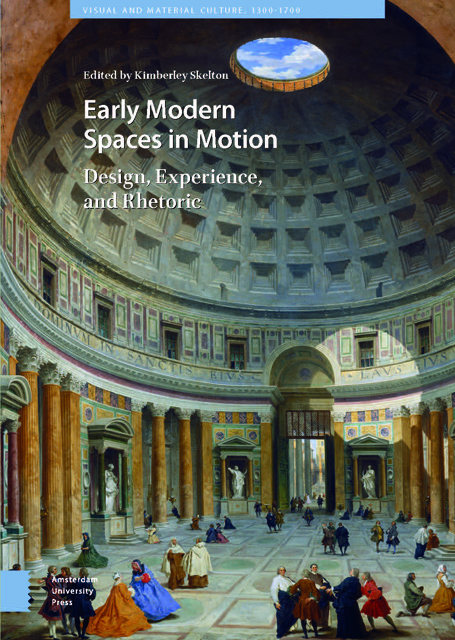Book contents
- Frontmatter
- Table of Contents
- List of Illustrations
- Acknowledgements
- Introduction: Bodies and Buildings in Motion
- 1 Navigating the Palace Underworld : Recreational Space, Pleasure, and Release at the Castello del Buonconsiglio, Trent
- 2 Passages to Fantasy : The Performance of Motion in Celliniâs Fontainebleau Portal and the Galerie François I
- 3 The Catholic Country House in Early Modern England : Motion, Pietyand Hospitality, c. 1580â1640
- 4 Sensory Vibrations and Social Reform at San Michele a Ripa in Rome
- 5 The Rise of the Staircase: Motion in Eighteenth-Century Dutch Domestic Architecture
- 6 Movement through Ruins: Re-experiencing Ancient Baalbek with Jean de la Roque
- 7 A Paper Tour of the Metropolis : The Architecture of Early Modern London in the Royal Magazine
- 8 Libraries in Motion: Forms of Movement in the Early Modern Library (1450-1770)
- Works Cited
- Index
1 - Navigating the Palace Underworld : Recreational Space, Pleasure, and Release at the Castello del Buonconsiglio, Trent
Published online by Cambridge University Press: 11 January 2023
- Frontmatter
- Table of Contents
- List of Illustrations
- Acknowledgements
- Introduction: Bodies and Buildings in Motion
- 1 Navigating the Palace Underworld : Recreational Space, Pleasure, and Release at the Castello del Buonconsiglio, Trent
- 2 Passages to Fantasy : The Performance of Motion in Celliniâs Fontainebleau Portal and the Galerie François I
- 3 The Catholic Country House in Early Modern England : Motion, Pietyand Hospitality, c. 1580â1640
- 4 Sensory Vibrations and Social Reform at San Michele a Ripa in Rome
- 5 The Rise of the Staircase: Motion in Eighteenth-Century Dutch Domestic Architecture
- 6 Movement through Ruins: Re-experiencing Ancient Baalbek with Jean de la Roque
- 7 A Paper Tour of the Metropolis : The Architecture of Early Modern London in the Royal Magazine
- 8 Libraries in Motion: Forms of Movement in the Early Modern Library (1450-1770)
- Works Cited
- Index
Summary
Abstract
This essay examines the material ornamentation and poetic description of garden-adjacent recreational spaces in the Magno Palazzo (main palace) of the Castello del Buonconsiglio, Trent (1528-1536). Guided by instructions from Prince- Bishop Bernardo Cles, a team of sculptors and painters including Dosso Dossi and Girolamo Romanino constructed a complex visual itinerary to orient mobile beholders and choreograph their movement through the newly built palace. Grounded in the precepts of decorum and commensurability, this itinerary was codified in an ekphrastic poem written by Cles’s physician, the naturalist Pietro Andrea Mattioli (published 1539). This essay traces the ways in which words and images prompt psychosensory response, revealing the moral ambivalence associated with marginal and unofficial interior spaces dedicated to refreshment, leisure, and entertainment.
Keywords: Girolamo Romanino, Bernardo Cles, Pietro Andrea Mattioli, court culture, Renaissance leisure, artistic itineraries
This essay explores the perception and experience of interior recreational spaces in Renaissance palaces, including the cantina, or wine cellar, and other chambers dedicated to informal dining, refreshment, and entertainment. Through the uniquely well-documented example of the Magno Palazzo, or main palace, of the Castello del Buonconsiglio at Trent, which was constructed in a unified programme of building and ornamentation between 1528 and 1536 for Bernardo Cles, Prince-Bishop of Trent (1484-1539), I trace the cues by which buildings and their decorative ensembles choreograph the apprehension, movement, and activity of individuals. The architectura features, painted programme, inscriptions, and sculpted ornamentation of the Magno Palazzo work together to articulate an experiential journey through shifting registers of order and decorum, creating a mobilized aesthetic of descent that guides the reception of beholders as they move from the official and public spaces of the palace’s main floor to those more private and secluded spaces dedicated to otium (leisure and productive recreation), including the ground-floor rooms situated at the perimeter of the garden. While all these material elements orient beholders as to the function of given spaces within the hierarchical structure of the palace, the frescoes in particular heighten the beholder’s somatic experience of movement and transition by incorporating psychosensory cues that set and disrupt expectations and prompt response.
- Type
- Chapter
- Information
- Early Modern Spaces in MotionDesign, Experience and Rhetoric, pp. 33 - 58Publisher: Amsterdam University PressPrint publication year: 2020



